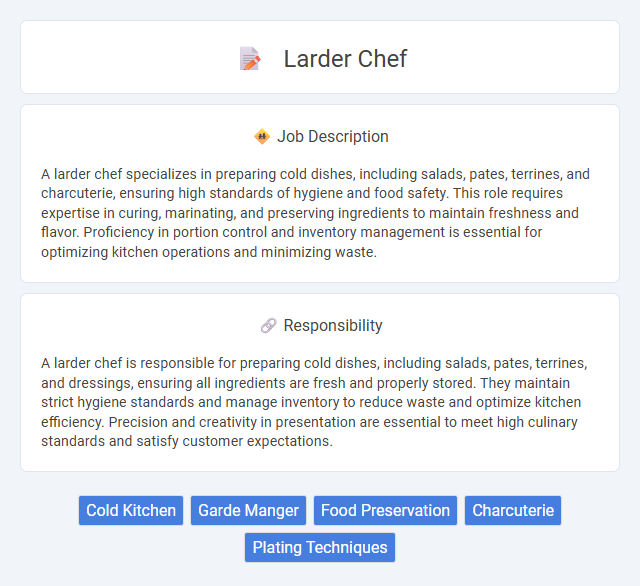
A larder chef specializes in preparing cold dishes, including salads, pates, terrines, and charcuterie, ensuring high standards of hygiene and food safety. This role requires expertise in curing, marinating, and preserving ingredients to maintain freshness and flavor. Proficiency in portion control and inventory management is essential for optimizing kitchen operations and minimizing waste.
People with strong organizational skills and an ability to work efficiently under pressure are likely to be well-suited for a larder chef position. Those who thrive in fast-paced environments and have a meticulous attention to detail probably find this role rewarding. Individuals who prefer repetitive tasks or lack stamina for long shifts may find the job challenging.
Qualification
A larder chef requires specialized expertise in cold food preparation, including charcuterie, pates, and terrines, often supported by formal culinary training from accredited institutions or apprenticeships. Proficiency in food safety standards, knife skills, and meticulous attention to detail ensures the highest quality standards in ingredient handling and presentation. Experience in inventory management, temperature control, and menu planning for cold dishes further enhances a larder chef's qualifications.
Responsibility
A larder chef is responsible for preparing cold dishes, including salads, pates, terrines, and dressings, ensuring all ingredients are fresh and properly stored. They maintain strict hygiene standards and manage inventory to reduce waste and optimize kitchen efficiency. Precision and creativity in presentation are essential to meet high culinary standards and satisfy customer expectations.
Benefit
A larder chef position probably offers the benefit of developing specialized skills in cold food preparation, which can enhance culinary expertise and career versatility. This role may provide opportunities for creative menu contributions and collaboration within a kitchen team, potentially leading to faster career advancement. Employees could also experience a structured work environment with consistent hours, offering a better work-life balance compared to other culinary roles.
Challenge
The larder chef role probably presents significant challenges related to maintaining high standards of food safety and hygiene while managing cold food preparation efficiently. This position often demands precise organization and creativity to ensure a variety of dishes are ready on time in a fast-paced kitchen environment. Handling these pressures successfully likely requires strong multitasking skills and the ability to work well under stress.
Career Advancement
A larder chef specializes in cold kitchen preparations, mastering skills such as curing, marinating, and plating, which form a strong foundation for advanced culinary roles. Progression typically leads to positions like sous chef, chef de cuisine, or specialized pastry and charcuterie chef, with opportunities to manage larger kitchen teams. Developing expertise in food preservation and presentation boosts employability in high-end restaurants, hotels, and catering companies.
Key Terms
Cold Kitchen
A larder chef specializes in preparing cold dishes such as salads, pates, terrines, and cured meats, ensuring high standards of hygiene and presentation. Expertise in knife skills, food preservation techniques, and ingredient sourcing is essential for optimizing freshness and flavor. Efficient organization and time management are critical to support seamless kitchen operations in the cold kitchen section.
Garde Manger
A Larder Chef specializing in Garde Manger expertly prepares cold dishes including salads, pates, terrines, and charcuterie. Mastery of knife skills, ingredient preservation, and food presentation is crucial for maintaining high standards in these visually and texturally diverse items. This role demands a deep understanding of flavor balance, hygiene protocols, and the creative assembly of cold appetizers and buffet items.
Food Preservation
A larder chef specializes in the preparation and preservation of cold dishes, using techniques such as curing, smoking, pickling, and marinating to extend the shelf life of meats, fish, and vegetables. Mastery of fermentation and vacuum-sealing methods ensures optimal freshness and flavor retention, critical for high-quality cold food production. Expertise in temperature control and hygiene standards maintains food safety while minimizing spoilage in the larder environment.
Charcuterie
A larder chef specializes in the preparation and presentation of charcuterie, mastering techniques such as curing, smoking, and seasoning meats to create artisanal products like pates, terrines, and sausages. Expertise in meat preservation and flavor development is essential for producing high-quality charcuterie that meets food safety standards. Larder chefs collaborate closely with kitchen teams to supply cold dishes and charcuterie boards that enhance menu variety and customer satisfaction.
Plating Techniques
A larder chef specializes in cold kitchen preparations, including salads, pates, terrines, and charcuterie, requiring precision in plating techniques to enhance visual appeal and flavor balance. Mastery of garnishing, arrangement symmetry, and color contrast is essential to create aesthetically pleasing dishes that maintain freshness and texture. Expertise in portion control and the use of tools like ring molds and tweezers ensures consistent presentation aligned with the restaurant's standards.
 kuljobs.com
kuljobs.com